The stage was set on a balmy summer night when musician, vocalist and indie favorite St. Vincent captivated the audience in a courtyard that once saw saints of another sort.
It was the opening night party for Hotel Saint Vincent in June, and it seemed like the A list was out in full force for one of the more posh hotel opening celebrations the city had seen in a long time.
The party was also a revelation: It showcased the long and winding road of the building complex constructed as an orphanage just after the Civil War into its current incarnation as a 75-room hotel developed during another seismic cultural and economic shift, the COVID-19 pandemic.
Hotel Saint Vincent is a project of MML Hospitality, helmed by Larry McGuire, Tom Moorman and Liz Lambert, whose expertise in developing hotels and restaurants — transforming, might be a better word — is seen in Austin, Texas, where the company is based.
The group worked with local developers Jayson Seidman and Zach Kupperman, who are part owners and developers. They are co-founders and developers of The Drifter in Mid-City, and Seidman is a co-owner and developer of the Columns, a late 19th-century Thomas Sully designed house turned hotel and bar that just went through its own re-do in 2020 and early 2021. Also part of the Hotel Saint Vincent ownership is real estate developer Christian Strobel.
The Austin-based developers said they feel at home in New Orleans. “It means so much to be part of New Orleans — it is real. There is grit and humor, kindness and Southern charm,” Liz Lambert said.
“People call you ‘baby’ and it feels so right. People root for each other,” she continued. “I couldn’t imagine a better place to be a host – to bring people together in respite from the everyday, locals and visitors alike, to give them a place to slip on a silk robe, to slow down and have an Aperol Spritz by the pool.”
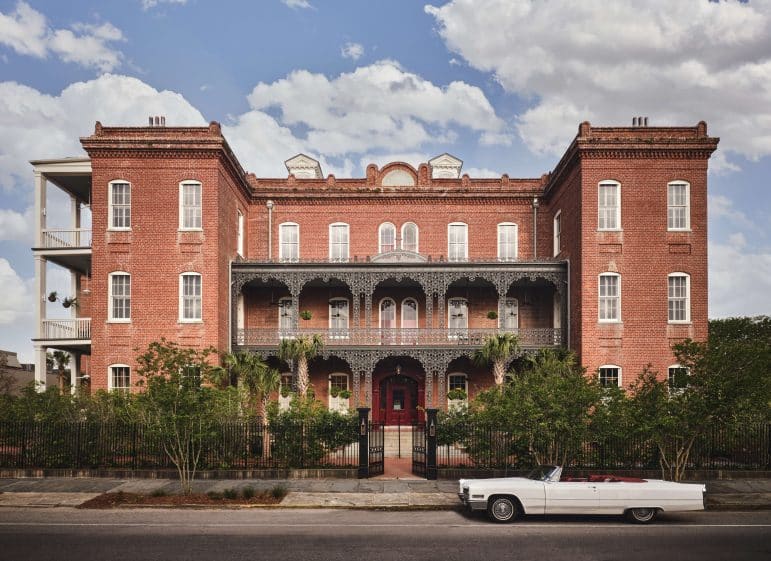
Douglas Friedman, courtesy of Hotel Saint Vincent
Hotel Saint Vincent, 1507 Magazine St.
Taking root
Located in the Lower Garden District, the monumental four-story red brick complex on the corner of Race and Magazine streets (uptown, lake side) was designed by Thomas Mulligan, with the cornerstone laid in 1864. The building held the St. Vincent Infant Asylum, founded at the request of the Daughters of Charity to be an orphanage, because many children had lost parents during the Civil War.
It was on the site of an old farmhouse, and was built in three stages, with the orphanage constructed first, followed by a building for expectant mothers, then a laundry and stables (“carriage house”) in the back. The federal government saw this institution as important to post-war recovery and paid the labor costs, including those of the former slaves who worked on it, according to “Margaret, Friend of Orphans,” by Mary Lou Widmer.
The Margaret of the book was Margaret Haughery, renowned in New Orleans for her philanthropy, with much of her money coming from her bakery. She was instrumental in initially funding the construction of St. Vincent’s, and set aside money in her will to maintain it and continue its mission after her death.
Facing Magazine Street, there are two wings connected in the middle, which is highlighted by cast-iron galleries. Those wings go back toward Camp Street (but not all the way) then are connected by another building, creating a courtyard. There is a gate on the Race Street side.
Changes to the exterior included gallery ceilings painted a traditional sky blue and hanging ferns were added. Bevelo gas lamps harken to the building’s 19th-century roots. Palm trees and a neon sign proclaiming the hotel give it a 1930s Los Angeles vibe.
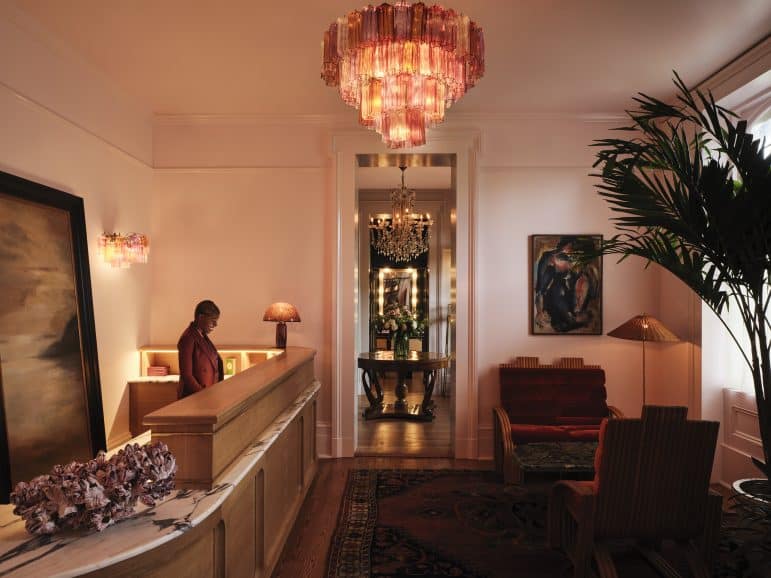
Matt Harrington, courtesy of Hotel Saint Vincent
The lobby features a Murano glass chandelier.
It’s the interior that has seen the biggest changes, of course. Lambert McGuire Design, the sister company of MML Hospitality, turned to Italy for its design inspiration.
A mid-century feel starts in the lobby and check-in area adorned with vintage Murano glass chandeliers and furniture that look like it was plucked from a chic Roman villa.
The Paradise Lounge’s mural hand painted by local artist Ann Marie Auricchio is a light and airy tropical scene highlighted by Bird of Paradise flowers and is the backdrop for hotel guests or cocktail enthusiasts to sit and enjoy libations. The custom tile floors are a recreation of tiles found elsewhere in the building. Right now, it looks like management is still fine-tuning the layout of the furniture, as subsequent visits have seen different configurations.
The lounge also has access to the front porch and to the courtyard, where there is a statue of the Virgin Mary in her own grotto.
The Chapel Bar is at the opposite end and, as of now, open to hotel guests only. It was, as the name indicates, the former chapel and according to lore, it was where unwed mothers would drop off their children.
Strictly for cocktails and late-night lounging, the feel here is lush velvets and deep, rich colors.
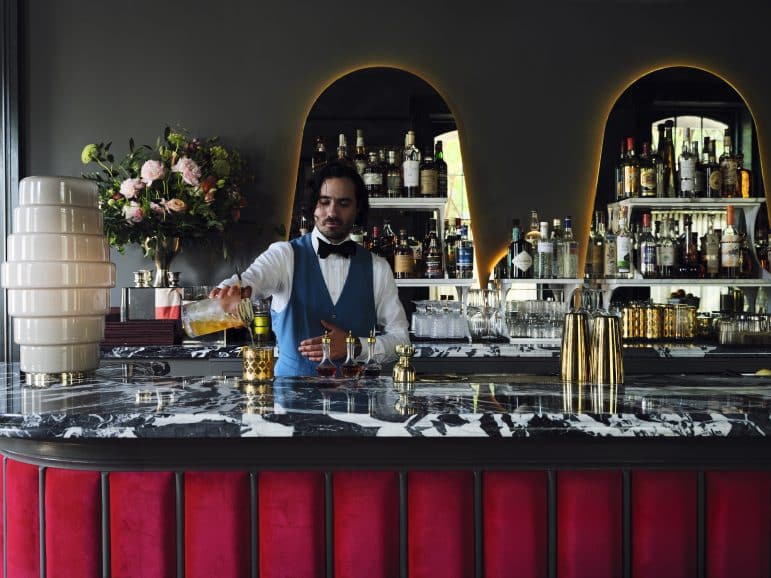
Matt Harrington, courtesy of Hotel Saint Vincent
The former chapel is now a bar for hotel guests.
Also for guests only (for now) is the Saltillo-lined pool and pool bar in the courtyard. Look up towards the back building and you will see a gargoyle by artist Thomas Randolf Morrison. It was there before the hotel renovation, and it has stayed, no doubt checking out the scene below.
San Lorenzo restaurant has a coastal Italian coastal flair in design and in cuisine, with touches of New Orleans with a menu (at publication) that includes a flounder piccata, summer truffle risotto, fresh linguine vongole and a raw bar that includes oysters and snapper tartare.
Rounding out the restaurant offerings is the Elizabeth Street Café New Orleans – an offshoot of an Austin café — which serves French-Vietnamese style cuisine and has a bakery.
The café has a direct view of the modern addition constructed to host special events, including art exhibitions, with the developers hoping to start community initiatives to utilize it.
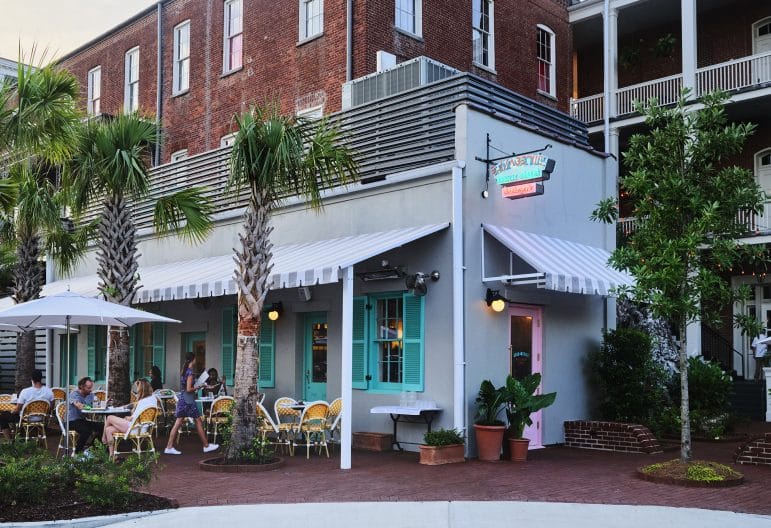
Matt Harrington, courtesy of Hotel Saint Vincent
Elizabeth Street Cafe NOLA
“I am most excited for the hotel to become part of the fabric of the city, for the music that will be played there, for the mothers who will be brought for brunch, for the reunions, the first dates, for the events, big and small, that wed a place to a city, and make it belong,” Lambert said.
There are a variety of rooms and suites, such as the Mary Suites which face the Virgin Mary grotto and Courtyard Kings that provide easy access to the pools. Rooms are painted in a gray achieved by mixing Farrow & Ball Elephant’s Breath with the company’s deeper Mole’s Breath creating a serene canvas for the artwork, decorative pieces, and beds so comfortable that luxuriating in the morning is almost a given.
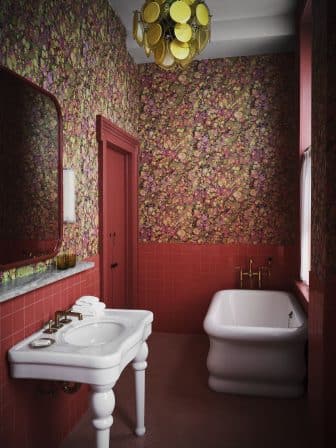
The designers liked the patterns so much they also used it for guest robes, as well as what the check-in staff wears as shirts or as other elements. And if you really like it, robes in that design are for sale at the in-house store ByGeorge — also an Austin import — a place to get luxurious clothing and items.
A beauty rediscovered, memories rekindled
The location of the building in the Lower Garden District was part of the claim by Jean Baptiste Le Moyne Sieur de Bienville, who founded New Orleans in 1718.
His property included land upriver from the French Quarter, extending along the east bank to about Nine Mile Point, then referred to “the bend above Chapitoulas.” Nine Mile Point is now unincorporated land in Jefferson Parish between Westwego and Bridge City, across the river from Ochsner Medical Center.
On the east bank, the area comprises Uptown, including the land between present-day Howard Avenue, Jackson Avenue, South Claiborne and the river, as well as adjacent areas of Jefferson Parish,
The land was granted to him by the Superior Council of Louisiana on March 27, 1719, and was confirmed by the Company of the Indies, proprietors of the Louisiana colony, in Paris on Feb. 6, 1720.
But before the Company of the Indies could confirm that, another royal order was issued Nov. 7, 1719, which forbade governors, lieutenant governors and intendants in the colony to possess plantations, allowing them to only have vegetable gardens.
Bienville’s way around this was order was to rent some of the land to settlers, including Germans who had been displaced by a hurricane in 1722.
He retained for his “vegetable garden,” the land between Canal and Felicity streets.
In 1726, Bienville sold 20 arpents to the Jesuits, who purchased an additional five arpents through Bienville’s nephew, the Sieur de Noyan, in 1728, to create a plantation. Following the end of the French and Indian War in 1763, the Jesuits were kicked out of the area with their possessions and lands seized and sold at public auction.
From there the land was sold and resold as part of plantations, parts of which were subdivided into faubourgs by Creole architect, city planner and surveyor Barthélemy Lafon.
Hotel Saint Vincent is located in what was named Faubourg de Annunciation.
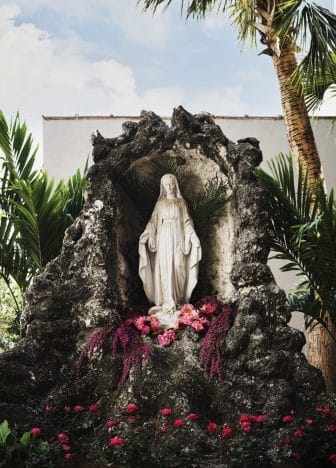
In 1992, Sally and Peter Schreiber purchased the building, renovating it into a bed-and-breakfast and hostel. Some may remember it also featured a teahouse.
Now, travelers and those looking for a dose of subliminal cool are now gracing the porches, courtyards and rooms of Hotel Saint Vincent. And maybe they will run into ghosts of orphans and mothers past — as a truly New Orleans hotel always has a spirited past.
Reporter Sue Strachan can be reached at suestrachan16@gmail.com.
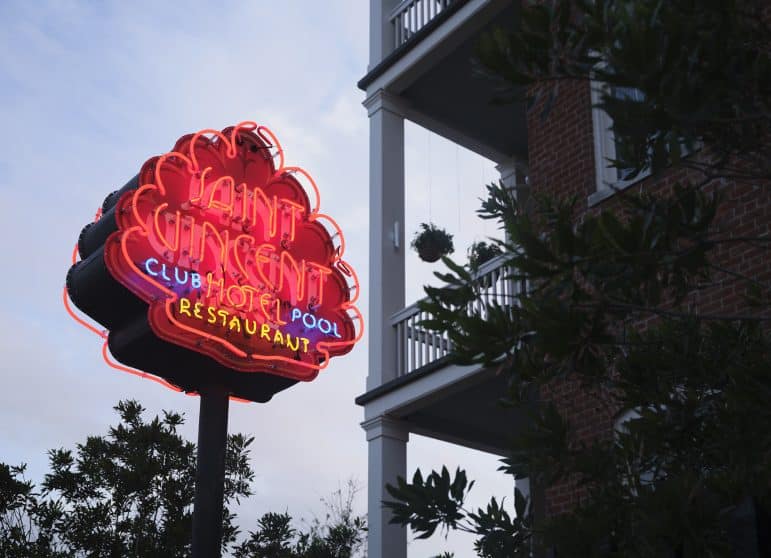
Lovely article, but the author omits some very important and disturbing elements about this new hotel, its developer/part owner and its management group. This property has been nothing but a nuisance and negative force on the lives and livelihoods of its neighbors since the moment it began construction of its new “events facility.” So much so that roughly thirty neighbors demanded and had a meeting with hotel management two weeks ago to require them to address the mess they have created and the disruptions to the lives of neighbors along Orange, Magazine and Camp Streets. I hope they paid well for this public relations stunt to sway the narrative.
Perhaps the author should talk with some of the neighbors of this property and residents who use Orange Street about the immense and immediate disruption to their lives caused by the lack of foresight, the incompetence and/or the outright deception by this property’s developer/part owner and his management group buddies. Maybe instead of focusing on the elite clientele and the opulent decor, the author could focus on the crumbling, stench filled residential street that has been left in the wake of Hotel St. Vincent’s utter disregard for the wellbeing of the community. They leave their dumpsters on the street for days at a time blocking on-street parking and traffic, hose them and their oil-soaked kitchen mats into city catch basins routinely and also routinely dump cooking pots into the catch basin of a street that already floods easily in a hard rain.
While glowingly praising the property and highlighting two physical sides of it, the author neglects completely the barren hellscape that Hotel St: Vincent has created for its neighbors along Orange Street and the cacophonous nightmare of both Orange Street and Camp Street which border the property’s new “events facility.” This property cares neither about this city, its residents nor its own neighbors. Despite all their fluffy, canned press-friendly responses, the development group and hotel ownership have at every turn from planning through to current execution and operation shown how little respect they have for the people who live adjacent in a residential zone.
A residential zone, neighboring residences and the narrow, one-way Orange Street have been turned into a de facto service alley for this sprawling over 70,000 square foot complex. Their new “events facility” whose front facing should be on Orange Street, instead, by use of manipulative tactics and variances, has been built just four feet from homes and altered to face the hotel rather than the mandated 200 feet from a residential zone by city zoning and face the Orange Street front of the lot. This leaves the entire back-of-house to fester in plain view of the neighbors, but effectively hides it from the hotel’s precious and fragile upscale and upper-class clientele.
This property couldn’t care less about New Orleans, its culture or it’s hard-working residents, only using both as props and pleasant cultural backdrops for the Instagram and Facebook feeds of the hotel and its upper management. Rather than truly creating a place woven respectfully into the fabric of New Orleans, they have brought in businesses that funnel money back to Austin and directly compete with neighboring family-owned and -operated small businesses.
They have created a situation that disrespects the neighborhood and neighbors consistently. They have built a new building and perimeter that is a blight on the residential and small business-oriented character of the area. And they did all of this through incompetence, manipulative practices, and outright deceit. They unfortunately are yet another developer and ownership group who in 2017 was able to game the system and pull the wool over the eyes of residents and city leaders.
They have left a residential street and area in shambles, littered with trash, dumpsters and upwards of 20 delivery trucks blocking the street and neighbors in their homes for hours each day. All of this was warned to be the result of this new “events facility” by the City Planning Commission’s professional staff in multiple reports and recommendations to deny this facility. Somehow though, against all reason and common sense, this developer/part owner and management group were able to weasel their way into yet another, fresh example of commercial development run amok. It’s a disgusting display of arrogance and disrespect to this city and particularly to the neighbors of Hotel St. Vincent.
What New Orleans needs is real Saints like Mrs Margret to restore this land to former foundations.
A religious community organization that fosters single mothers and children
Is what needs to be restored